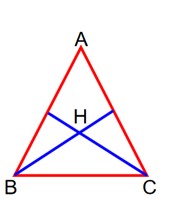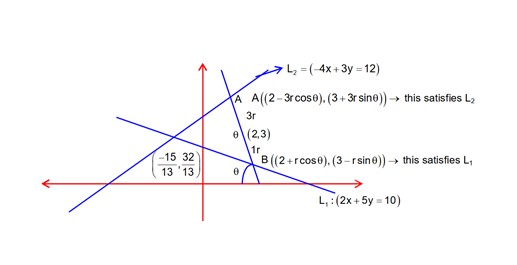Three Dimensional Geometry
Get insights from 212 questions on Three Dimensional Geometry, answered by students, alumni, and experts. You may also ask and answer any question you like about Three Dimensional Geometry
Follow Ask QuestionQuestions
Discussions
Active Users
Followers
New answer posted
3 months agoContributor-Level 10
and
AB2 = 84
f(-1) = 1
f(1) = 3
Hence f(x) will be discontinuous at x = 1 and also 4x2 – 1 = 0 , 1 , 2
New answer posted
4 months agoContributor-Level 10
(x, y, z) = (3, 6, 5)
now point Q and line both lies in the plane.
So, equation of plane is
2x – z = 1
option (B) satisfies.
New answer posted
4 months agoContributor-Level 10
Let AB
AC
So vertex A = (1, 1)
altitude from B is perpendicular to AC and passing through orthocentre.

So, BH = x + 2y – 7 = 0
CH = 2x + y – 7 = 0
now solve AB & BH to get B (3, 2) similarly CH and AC to get C (2, 3) so centroid is at (2, 2)
New answer posted
4 months agoLet lie on the plane px – qy + z = 5, for some The shortest distance of the plane form the origin is
Contributor-Level 10
Line to the normal
⇒ 3p + 2q – 1 = 0
lies in the plane 2p + q = 8
From here p = 15, q = -22
Equation of plane 15x – 22y + z – 5 = 0
Distance from origin = √5/142
New answer posted
4 months agoContributor-Level 10
Equation of perpendicular bisector of AB is
Solving it with equation of given circle,
But
because AB is not the diameter.
So, centre will be
Now,
New answer posted
4 months agoContributor-Level 10
any pt on it is P
M (h, k) be mid point of P & A (4, 3)
Required locus (x – 2)2 +
New answer posted
4 months agoTaking an Exam? Selecting a College?
Get authentic answers from experts, students and alumni that you won't find anywhere else
Sign Up on ShikshaOn Shiksha, get access to
- 65k Colleges
- 1.2k Exams
- 679k Reviews
- 1800k Answers

